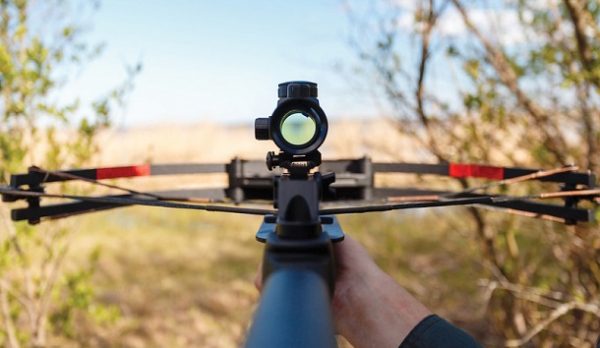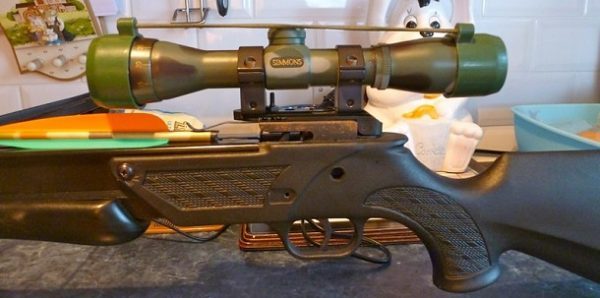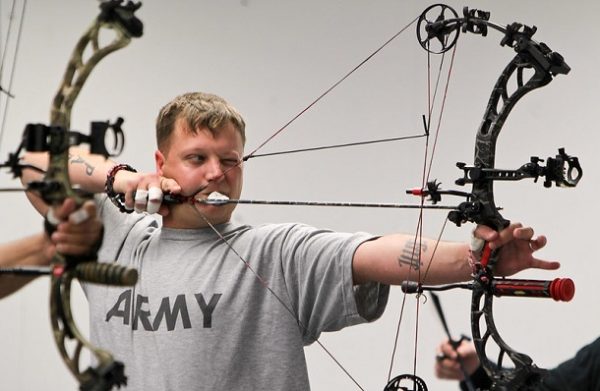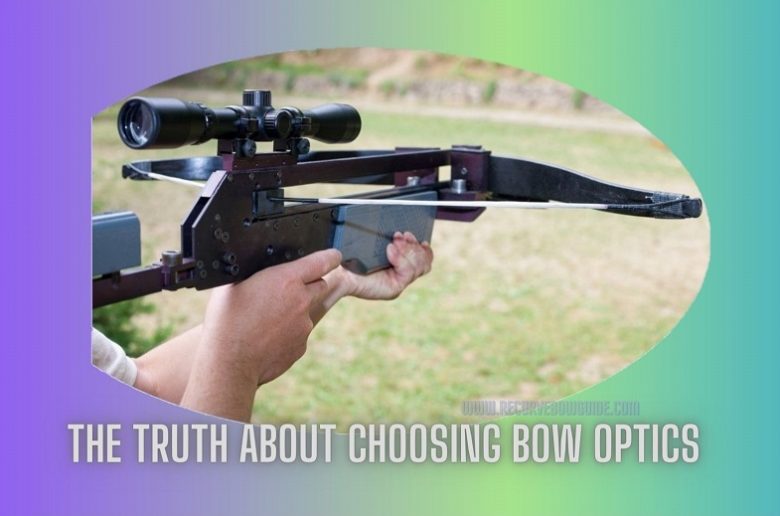Choosing an optical sight for a bow and crossbow is very difficult. The fact is that the arrow’s speed is quite low, even if you compare it with a pneumatic bullet.
Most scopes are designed for rifled firearms. The rifle has a direct shot range of 150-200 meters on average. But the crossbow does not have it at all, and the maximum distance of real fire is only 50-60 meters. This is one or two times less than that of a rifle.
Choosing a telescopic sight reticle for crossbow and bow
Crossbow shooting is different from a rifle. The trajectory of the arrow does not please with flatness. Even at distances that are ridiculous for a rifled weapon, corrections (shift of the aiming point) must be introduced every ten meters. Therefore, a simplified reticle like duplex or stump is not suitable here.
At a minimum, you need a mildot or an original crossbow aimed at the following distances. All crossbows are different, and arrows are also different. And crossbow nets are not designed for meters but yards (0.91 m).
The collimator must have not one but several sighting marks red dot.
Even from the budget segment, most of the full-size block and recursive crossbows are equipped as standard with an optical sight with an original reticle. But with it, the exact correspondence of the divisions of the vertical scale to certain distances will not be. All crossbows are different, arrows are also different, and the trajectory of a 350-grain projectile looks completely different from that of a 433 grain one (1 grain = 0.0648 grams). Crossbow nets are rated for yards (0.91 m).

Choosing an optical sight:
Requirements for the mechanical strength of the sight for a shooter without the recoil of a crossbow are very low. For recreational shooting, you are unlikely to need a sealed enclosure filled with dry nitrogen. Somehow it is not customary to run with bows-crossbows in a downpour. The problem of fogging up the optics with a sharp temperature change is easy and free of charge. You don’t have to rush to remove the device from the case when going from warm to cold and vice versa.
A compact, relatively simple, and budgetary sight is quite enough for simple purposes, which has only the most necessary options.
Even the cheapest sight is equipped with an original crossbow reticle. This is where the listing of its merits ends. But for recreational shooting, this is quite enough. Authentic, it can only be recommended to people with excellent eyesight. There is no eyepiece diopter adjustment.
Magnification
If you are confused by the low magnification ratio, do not be discouraged. 4×32 is just the standard designed for short firing distances. It is these distances that are characteristic of crossbow practice. There is optimally low magnification. By the way, the PSO-1 sniper scope with a correction scale marking up to 1300 meters has the characteristics of 4×24. In the vast majority of cases, shooting with it is carried out up to 600 meters. For a powerful hunting crossbow, again, the real aiming range is 60 meters.
There are many similar scopes under different names, slightly different in price. It comes with or without grid backlit. Some are produced under the brands of well-known manufacturers. They cost about twice the Chinese counterparts. And although they were not made in the USA, they fully meet the requirements.
And yet, the choice of scopes with the original crossbow reticle is quite narrow. It is much easier to choose a versatile device with a mildot. It will be affordable. In this case, the sight will have more serious characteristics, including strength. These can be installed on pneumatics, including rifles of the magnum class.
Manufacturer
They are produced under the brand name of a well-known manufacturer. They are made with the illumination of the aiming mark, diopter adjustment, coated optics, and parallax adjustment (the main problem of shooters at short distances).
If you plan to regularly use the scope mainly for serious purposes and tasks, slightly increase your budget. But for a reasonable price, you will get an even higher level.
In addition to diopter adjustment for vision features, such scopes have enlightened optics, multicolor stepped illumination of the Mildot reticle, a sealed nitrogen-filled housing, tactical correction drums, and parallax offset.

Tactical drums for a crossbow are needed exclusively for quick re-shooting, say, at a storage shed, Hunting with a crossbow for a wild boar. There is no need to unscrew and tighten the protective scope covers. Prompt entry of corrections directly during shooting is more relevant for rifled firearms, and even there, it is better to do this on a grid. But the phenomenon of parallax is more complex, especially at short and basic hunting crossbow distances of 20 and 30 meters. Even the low magnification of the sight does not always save him from it, although experience helps.
Don’t chase novelty:
pancratic sights, built-in laser designators, and the same. Neither in natural crossbow hunting nor even more so in recreational shooting, all this will not be useful to you but will only worsen the device’s resistance to external influences. The latter property is especially noticeable in cheap scopes. They are already not very well-made, and the saturation of additional options only leads to an accelerated failure.
Optimal performance for bow and crossbow scopes
The minimum OP stats for a crossbow will be as follows:
● multiplicity 4×32;
● original mesh or “mildot”;
● sealed housing;
● detuning from parallax;
● mesh backlight;
● diopter adjustment (you can do without it with excellent vision).
Where to turn the sight drums?
There is a vertical and horizontal Midpoint of Hit adjustment in the crossbow scope. Drums/handwheels carry it out.
All-optical sights are equipped with some prompts, printed directly on the handwheels for entering corrections. To shift the middle point up, rotate the top drum in the «UP» direction, down «Down», the side one serves to shift to the left (Left) and the right (Right). And on the ends of rare military devices, like PSO-1, there is another help.
On the side, there are right» and «left», on the top «up» and «down». If we are not talking about the so-called «tactical» drums with open scales, then before tuning, you need to unscrew the protective covers and find the correction drums under them.

Parallax: what is it?
The phenomenon of parallax makes life difficult for fans of pneumatics and crossbows. Not only is it inconvenient to aim, but also accuracy suffers greatly.
This is caused by the desire of some crossbow shooters to acquire cool long-focus sights of large magnification. It is they who are subject to parallax at short (typical for this weapon) distances. Manufacturers have to resort to complicating the design by introducing parallax detuning (focusing) mechanisms. With the simple technology on the lens and the high-quality SF, the detuning flywheel is sometimes a rear wheel on the sight side.
On a crossbow or a conventional air spring-piston rifle designed for hunting, a 9x, 12x scope is not needed. With high-precision shooting, made from a stop and even a machine tool, you cannot do without them. When shooting from hands, in addition to parallax, we get a cross jumping on a target. The desire to catch its center is one of the main aiming mistakes.
On all hunting crossbows, including high-end ones, the standard sight has modest 4×32 characteristics. The practical shooting distance is from 20 to 50 meters. In addition, if in crossbow sports, the diameter of a tens is 4.5 mm, then a boar or deer have a 15 cm kill zone. That is, the magnification of 9x is not relevant for a sight?
For sports bows (as well as rifles), any optics is generally prohibited. They use ring sights.
Our advice. Choose up to a maximum of 6x scope with tactical correction drums, diopter adjustment, and reticle illumination. These options are enough.
Pancratic scopes are initially more gentle. High magnification is not needed at any reasonable distance.
Non-long-focus sights also showed good resistance to scrapes from the budget options. They are not too expensive but will last a very long time.
